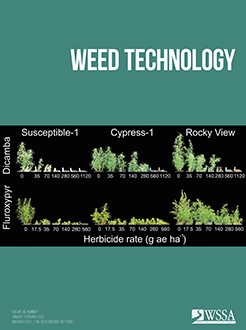Drought stress and weed competition are two of the most important threats to corn production in the northeastern United States. Both pressures have the potential to worsen under climate change. In a 2-yr field study in Ithaca, NY, we tested the effects of drought and burcucumber, an increasingly problematic annual vine, on silage corn. Burcucumber seedlings were transplanted into corn rows at densities of 0, 0.5, 2, and 3 plants m–2 and a drought treatment was later imposed with rainout shelters constructed from steel frames and high-clarity plastic. Available soil moisture was lower in drought plots (47% ± 1% in 2018 and 52% ± 2% in 2019) than no-drought plots (69% ± 1% in 2018 and 68% ± 1% in 2019). Burcucumber planting density (P = 0.008) reduced fresh silage yield. Drought also reduced fresh silage yield (P < 0.001) with a drought-by-year interaction (P = 0.007): drought reduced fresh weight by 29% in 2018 (48,000 ± 2,000 kg ha–1 to 34,000 ± 3,000 kg ha–1) and by 9% in 2019 (38,000 ± 3,000 kg ha–1 to 34,000 ± 3,000 kg ha–1). Burcucumber planting density and drought did not interact. Overall, our findings indicate that drought and competition from burcucumber may have additive effects on silage corn in New York State. Regardless of water availability, active weed management is required to prevent yield losses due to burcucumber. Yield losses may be similar or greater in grain corn and might increase under climate change.
Nomenclature: burcucumber; Sicyos angulatus L.; corn; Zea mays L.






